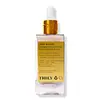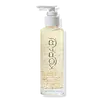What's inside
What's inside
 Key Ingredients
Key Ingredients

 Benefits
Benefits

 Concerns
Concerns

 Ingredients Side-by-side
Ingredients Side-by-side

Aloe Barbadensis Leaf Juice
Skin ConditioningWater
Skin ConditioningJojoba Oil/Caprylic/Capric Triglyceride Esters
Skin ConditioningVanilla Planifolia Fruit Extract
Skin ConditioningPaullinia Cupana Seed Extract
Skin ConditioningPhenoxyethanol
PreservativeTetrasodium Glutamate Diacetate
Tocopherol
AntioxidantParfum
MaskingPolyglutamic Acid
Skin ConditioningCeramide NP
Skin ConditioningCeramide AP
Skin ConditioningCeramide EOP
Skin ConditioningPhytosphingosine
Skin ConditioningCholesterol
EmollientSodium Lauroyl Lactylate
EmulsifyingCarbomer
Emulsion StabilisingXanthan Gum
EmulsifyingCI 17200
Cosmetic ColorantCI 60725
Cosmetic ColorantAloe Barbadensis Leaf Juice, Water, Jojoba Oil/Caprylic/Capric Triglyceride Esters, Vanilla Planifolia Fruit Extract, Paullinia Cupana Seed Extract, Phenoxyethanol, Tetrasodium Glutamate Diacetate, Tocopherol, Parfum, Polyglutamic Acid, Ceramide NP, Ceramide AP, Ceramide EOP, Phytosphingosine, Cholesterol, Sodium Lauroyl Lactylate, Carbomer, Xanthan Gum, CI 17200, CI 60725
Helianthus Annuus Seed Oil
EmollientC12-15 Alkyl Benzoate
AntimicrobialButyrospermum Parkii Oil
EmollientParfum
MaskingCaprylic/Capric Triglyceride
MaskingCocos Nucifera Oil
MaskingTocopherol
AntioxidantGlycine Soja Oil
EmollientSqualane
EmollientRicinus Communis Seed Oil
MaskingGold
Cosmetic ColorantSodium Hyaluronate
HumectantHydrogenated Castor Oil
EmollientBenzyl Alcohol
PerfumingCoumarin
PerfumingHexyl Cinnamal
PerfumingCI 77820
Cosmetic ColorantCI 77400
Cosmetic ColorantHelianthus Annuus Seed Oil, C12-15 Alkyl Benzoate, Butyrospermum Parkii Oil, Parfum, Caprylic/Capric Triglyceride, Cocos Nucifera Oil, Tocopherol, Glycine Soja Oil, Squalane, Ricinus Communis Seed Oil, Gold, Sodium Hyaluronate, Hydrogenated Castor Oil, Benzyl Alcohol, Coumarin, Hexyl Cinnamal, CI 77820, CI 77400
 Reviews
Reviews

Ingredients Explained
These ingredients are found in both products.
Ingredients higher up in an ingredient list are typically present in a larger amount.
Parfum is a catch-all term for an ingredient or more that is used to give a scent to products.
Also called "fragrance", this ingredient can be a blend of hundreds of chemicals or plant oils. This means every product with "fragrance" or "parfum" in the ingredients list is a different mixture.
For instance, Habanolide is a proprietary trade name for a specific aroma chemical. When used as a fragrance ingredient in cosmetics, most aroma chemicals fall under the broad labeling category of “FRAGRANCE” or “PARFUM” according to EU and US regulations.
The term 'parfum' or 'fragrance' is not regulated in many countries. In many cases, it is up to the brand to define this term.
For instance, many brands choose to label themselves as "fragrance-free" because they are not using synthetic fragrances. However, their products may still contain ingredients such as essential oils that are considered a fragrance by INCI standards.
One example is Calendula flower extract. Calendula is an essential oil that still imparts a scent or 'fragrance'.
Depending on the blend, the ingredients in the mixture can cause allergies and sensitivities on the skin. Some ingredients that are known EU allergens include linalool and citronellol.
Parfum can also be used to mask or cover an unpleasant scent.
The bottom line is: not all fragrances/parfum/ingredients are created equally. If you are worried about fragrances, we recommend taking a closer look at an ingredient. And of course, we always recommend speaking with a professional.
Learn more about ParfumTocopherol (also known as Vitamin E) is a common antioxidant used to help protect the skin from free-radicals and strengthen the skin barrier. It's also fat soluble - this means our skin is great at absorbing it.
Vitamin E also helps keep your natural skin lipids healthy. Your lipid skin barrier naturally consists of lipids, ceramides, and fatty acids. Vitamin E offers extra protection for your skin’s lipid barrier, keeping your skin healthy and nourished.
Another benefit is a bit of UV protection. Vitamin E helps reduce the damage caused by UVB rays. (It should not replace your sunscreen). Combining it with Vitamin C can decrease sunburned cells and hyperpigmentation after UV exposure.
You might have noticed Vitamin E + C often paired together. This is because it is great at stabilizing Vitamin C. Using the two together helps increase the effectiveness of both ingredients.
There are often claims that Vitamin E can reduce/prevent scarring, but these claims haven't been confirmed by scientific research.
Learn more about Tocopherol